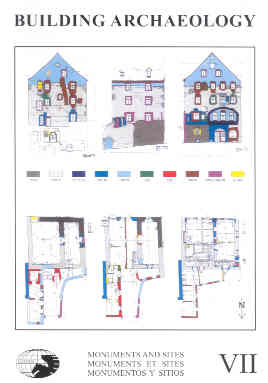[Ferrol, España / Spain, 1, 2 y 3 de octubre de 2004]
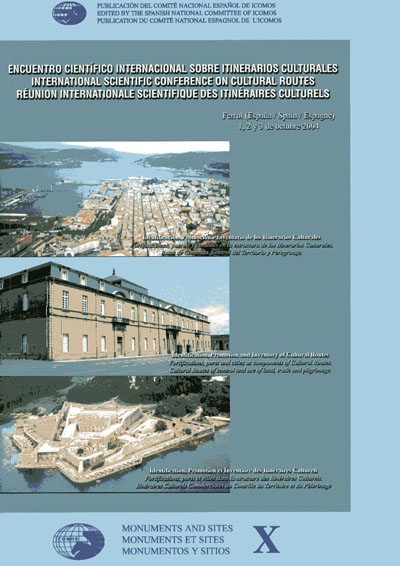
Fortificaciones, puertos y ciudades
en la estructura de los Itinerarios Culturales.
Rutas de Comercio, Control del Territorio y Peregrinaje
Monuments and Sites: X
2005
841 pages out of stock - épuisé
INDICE / CONTENTS / INDEX
- PRESENTACION / PRESENTATION
- PREFACIO / FOREWORD / PREFACE
- SALUTACION DEL ALCALDE
- GREETING OF THE MAYOR OF FERROL / SALUT DU MAIRE DE FERROL
- LOS ITINERARIOS CULTURALES. UNA NUEVA CATEGORIA CONCEPTUAL DEL PATRIMONIO PARA LA COMPRENSION Y LA PAZ
I. AFRICA
1.1. ROUTES EURO-AFRICAINES
Fort portugais de Ouidah (Fiche d'inventaire de fortifications d'un itinéraire culturel). Aimé Gonçalves (Benin)
1.2. ROUTES INTERAFRICAINES
Agbogbovi et Agbogbo. Enceintes de la cité de Notsé (Fiche d'inventaire de fortifications bastionnées d'un itinéraire culturel). Amossou Gael (Togo)
1.3. ROUTES DES CARAVANES EN AFRIQUE
Route de caravanes en Afrique: un example d'itinéraire Culturel entre le Nord, le Sud Sahara et le reste du monde (Fiche d'identification d'un Itinéraire Culturel). Dosso Sindou (Côte d'Ivore)
II. AMERICA
II.1.EL CAMINO REAL INTERCONTINENTAL EN AMERICA
Camino Real intercontinental (Datos complemetarios para la ficha de Identificación elaborada por Maria Isabel Navarro y publicada en "El Patrimonio Intangible y otros aspectos de los Itinerarios Culturales", del CIIC. Edición del Gobierno de Navarra,Pamplona, España,2002). Francisco Muñoz Espejo (México).
Antecedentes históricos del Sistema Defensivo de la Nueva España (Datos para la Identificación del Inventario de un tramo de un itinerario cultural). Francisco Muñoz Espejo (México)
Fuerte de Villa Rica (Ficha de Inventario de Fortificaciones de un Itinerario Cultural). Francisco Muñoz Espejo (México)
Fuerte de San Juan de Ulúa (Ficha de Inventario de Fortificaciones de un Itinerario Cultural). Francisco Muñoz Espejo (México)
Baluarte de Santiago. Veracruz (Ficha de Inventario de Fortificaciones de un Itinerario Cultural). Francisco Muñoz Espejo (México)
Sistema defensivo de Campeche (Ficha de Inventario de Fortificaciones de un Itinerario Cultural). Francisco Muñoz Espejo (México)
Fortaleza abaluartada de San Diego. Acapulco (Ficha de Inventario de Fortificaciones de un Itinerario Cultural). Francisco Muñoz Espejo (México)
Fortaleza abaluartada de San Carlos de Perote (Ficha de Inventario de Fortificaciones de un Itinerario Cultural). Francisco Muñoz Espejo (México)
Fortaleza de San Felipe de Bacalar (Ficha de Inventario de Fortificaciones de un Itinerario Cultural). Francisco Muñoz Espejo (México)
Fortaleza abaluartada de Guadalupe. Puebla (Ficha de Inventario de Fortificaciones de un Itinerario Cultural). Francisco Muñoz Espejo (México)
Fortaleza abaluartada de Loreto.Puebla (Ficha de Inventario de Fortificaciones de un Itinerario Cultural). Francisco Muñoz Espejo (México)
Sistema defensivo de Portobelo (Ficha de Inventario de Fortificaciones de un Itinerario Cultural) Francisco Muñoz Espejo (México)
El Camino Real Intercontinental y su conexión con Cuba. Tamara Blanes (Cuba)
Camino Real e Intercontinental. Características específicas de los Puertos y ciudades de la Habana.Santiago de Cuba y Trinidad como ejes fundamentales del tráfico comercial de la Flota Española durante los siglos XVI A XVIII. (Ficha de Identificación de un tramo de Itinerario Cultural) Tamara Blanes (Cuba).
Registro de Proyecto de Promoción de un tramo del Camino Real.Cuba. Tamara Banes (Cuba)
La Habana. (Ficha de Inventario de ciudades y poblaciones históricas de un Itinerario Cultural). Tamara Blanes. (Cuba)
Santiago de Cuba (Ficha de Inventario de ciudades y poblaciones históricas de un Itinerario Cultural). Tamara Blanes. (Cuba)
Trinidad (Ficha de Inventario de ciudades y poblaciones históricas de un Itinerario Cultural). Tamara Blanes (Cuba)
Batería No.1 (Ficha de Inventario de fortificaciones de un Itinerario Cultural). Tamara Blanes. (Cuba)
Castillo de San Pedro de la Boca del Morro . (Ficha de Inventario de fortificaciones de un Itinerario Cultural) Tamara Blanes (Cuba)
Fuerte Conde de Mirasol. (Ficha de Inventario de fortificaciones de un Itinerario Cultural). Milagros Flores (Puerto Rico)
Bateria España.Isla Margarita (Venezuela) (Ficha de Inventario de fortificaciones de un Itinerario Cultural) Autores varios
Batería La Caranta.Isla Margarita. (Venezuela) (Ficha de Inventario de fortificaciones de un Itinerario Cultural) Autores varios
Batería La Libertad.Isla Margarita. (Venezuela) (Ficha de Inventario de fortificaciones de un Itinerario Cultural) Autores varios
Batería Matasiete. Isla Margarita. (Venezuela) (Ficha de Inventario de fortificaciones de un Itinerario Cultural) Autores varios
Baterías la Galera. Isla Margarita. (Venezuela) (Ficha de Inventario de fortificaciones de un Itinerario Cultural) Autores varios
Castillo San Carlos Borromeo. Isla Margarita. (Venezuela) (Ficha de Inventario de fortificaciones de un Itinerario Cultural) Autores varios
Castillo Santa Rosa. Isla Margarita. (Venezuela) (Ficha de Inventario de fortificaciones de un Itinerario Cultural) Autores varios
Trinchera El Calvario.Margarita (Venezuela).(Ficha de Identificación de de un tramo de un Itinerario Cultural) Autores varios)
El Camino Real de Chihuahua. (Ficha de Identificación de de un tramo de un Itinerario Cultural). Celia Calderón. (México)
Paisaje Cultural del Río Conchos. (Ficha de Identificación de de un tramo de un Itinerario Cultural).Autores varios). Celia Calderón.(México)
Valle de San Bartolomé (hoy de Allende). (Ficha de Inventario de ciudades y poblaciones históricas de un Itinerario Cultural). Celia Calderón. (México)
San Javier del Río Florido.(Ficha de Inventario de ciudades y poblaciones históricas de un Itinerario Cultural). Celia Calderón. (México)
Santa Rosalía.(Ficha de Inventario de ciudades y poblaciones históricas de un Itinerario Cultural). Celia Calderón. (México)
San Buenaventura de Atotonilco. (Ficha de Inventario de ciudades y poblaciones históricas de un Itinerario Cultural). Celia Calderón. (México)
Huejuquilla. (Ficha de Inventario de ciudades y poblaciones históricas de un Itinerario Cultural). Celia Calderón. (México)
Torreón de Cañas. (Ficha de Inventario de ciudades y poblaciones históricas de un Itinerario Cultural). Celia Calderón. (México)
Torreón de Salgado. (Ficha de Inventario de ciudades y poblaciones históricas de un Itinerario Cultural). Celia Calderón. (México)
Mesón de Florido. (Ficha de Inventario de ciudades y poblaciones históricas de un Itinerario Cultural).Celia Calderón. (México)
Hacienda de Sombreretillo (Cuadra de posta o descanso).(Ficha de Inventario de arquitectura civil y fortificaciones de un itinerario cultural). Celia Calderón. (México)
Presidio de Marteleño. (Ficha de Inventario de fortificaciones de un Itinerario Culrtural). Celia Calderón. (México)
Presidio de Ojo Blanco. (Ficha de Inventario de fortificaciones de un Itinerario Culrtural). Celia Calderón. (México)
Ciudad de Espiritu Santo de Esparza. (Ficha de Inventario de ciudades y poblaciones históricas de un Itinerario Cultural). Carlos Mesén. (Costa Rica)
Imagen de Nuestra Señora de los Angeles. Patrona de Costa Rica. (Ficha de inventario de bienes muebles y patrimonio tangible de un Itinerario Cultural). Thelma Carrera (Costa Rica)
Litoral del Estado Aragua, o Ruta del Cacao. (Ficha de Inventario de paisaje cultural de un Itinerario Cultural). Carmen Daly ( Venezuela)
Tramo Histórico Córdoba del Tucumán-Lima, parte del Camino Real Intercontinental. (Ficha de Identificación de un tramo de un Itinerario Cultural) Edwin Binda (Chile)
Quebrada de Humahuaca. (Ficha de Identificación de un tramo de un Itinerario Cultural). Carlos Pernaut (Argentina)
Puerto La Plata. (Ficha de Inventario de Patrimonio histórico industrial de un Itinerario Cultural). Alfredo Conti (Argentina)
Bahía de Montevideo y su entorno. (Ficha de inventario de paisaje cultural de un Itinerario Cultural). Ana Maria Crespi (Uruguay)
Humaitá. Nombre original: Huma itá (piedras negras). (Ficha de inventario de fortificaciones de un Itinerario Cultural). Ana Maria Crespi (Uruguay)
II.2.LA RUTA DEL AZUCAR EN BRASIL
La Ruta del Azucar-Salvador-Recôncavo de Baía/Brasil (Ficha de Identificación de un Itinerario Cultural) Adriana Castro. (Brasil)
La ciudad fortificada portuaria de Salvador de Bahía y la fortificación de San Marcelo. (Ficha de Identificación de bienes inmuebles de un Itinerario Cultural). Adriana Castro. (Brasil)
Fortaleza de Sao Marcelo o Fortaleza Del Mar o Fortaleza de Nossa Senhora de Pópulo (Ficha de inventario de fortificaciones de un Itineraio Cultural). Adriana Castro (Brasil)
II.3 THE HISTORIC COLUMBIA HIGHWAY
Historic Columbia River Highway, State of Oregon, United Estates (Record for identification for a cultural Route). Dan Marriot (U.S.A.)
Historic Columbia River Highway.Restoration, Rehabilitation, Rapair and Reconstruction of the 1915-1922 Highway (Record for a project to promote a Cultural Route). Dan Marriot (U.S.A)
Historic Columbia River Highway (Inventory Record for cuultural landscapes of a Cultural Route). Dan Marriot (U.S.A)
III.ASIA
III.TRADE AND SALT ROUTES IN INDIA
Trade and Salt Route of Jammu & Kashmir (Record for Identification of a Cultural Route). Poonam Chaudhary (India)
III.2 SPICE TRADE AND PILGRIMAGES ROUTE IN ASIA
Spice Trade and Pilgrimage Route in Asia (Record for Identification of a Cultural Route). Samitha Manawadu (Sri Lanka)
III.3.EURO-ASIAN CULTURAL ROUTES
Documentation for Conservation of Fortified Cities in Sri Lanka.(Record for a project to promote fortified elements of a Cultural Route). Samitha Manawadu (Sri Lanka)
Historic Fort of Galle ( World Heritage Site).(Inventory record for historic cities and towns on a Cultural Route). Samitha Manawadu (Sri Lanka)
The fortification system of the Fortified City of Galle. (Inventory record for fortifications of a Cultural Route).Samitha Manawadu (Sri Lanka)
III.4.THE INCENSE AND SPICE ROUTE
The incense and Spice Route and the Desert Cities in the Negev. (Record for identidication of a part of a Cultural Route). Avi Shoket (Israel)
Theincense andSpiceRouteandthe Desert Cities (Inventory record forfortifications on a Cultural Route).Avi Shket (Israel)
III.5.CULTURAL ROUTEBETWEEN KOREA AND JAJPAN
The Route of communication missions from the korean dynasty to JAPAN. (Record for identificacion of a Cultural Route). Kunie Sugio (Japan)
III.6.THE INTERCONTINENTAL SILVER ROUTE
Historic Port Tows that are of a Cultural Route: Historic Port Towns for Silver Shipping (Record for identification of a Cultural Route (annex)). Kunie Sugio (Japan)
IV.EUROPA
IV.1.EL CAMINO DE SANTIAGO
Camino de Santiago, en su tramo conocido como "Camino Francés".Tramo delac Provincia de Burgos, en la Comunidad Autónoma de Castilla y León (España).
(Ficha de diagnosis de y reconocimiento de un tramo de un Itinerario Cultural). Alberto Martorell (Perú)
Hospital del Sancti Spiritus (Ficha de Inventariode inmueblesdein Itinerario Cultural didicados a las obras públicas).Maria Esther del Castillo (España)
IV.2.EL CAMINO REAL INTERCONTINENTAL EN ESPAÑA
Ficha de Puertos:Una Propuesta a partir del ejemplo del Ferrol. (Ficha deinventario de un puerto (de mar) de un Itinerario Cultural). Juan Antonio Rodriguez-Villasante (España)
Madrid en el Camino Real.(Ficha de Inventario de ciudades y poblaciones históricas de un Itinerario Cultural). Alicia Cahn (Argentina)
La Mineria en el Camino Real. Almadén. José Maria Garcia de Miguel (España)
Mina de Almadén (Ciudad Real).
(Ficha de inventario de conjuntos histórico-mineros de un Itinerario Cultural). Rocio Cutipé Cardenas (Perú)
Mina de Las Médulas (León).
(Ficha de inventaro de conjuntos histórico-mineros de un Itinerario Cultural). Rocio Cutipé Cardenas (Perú)
Mina la Tortilla (Linares)
(Ficha de inventaro de conjuntos histórico-mineros de un Itinerario Cultural). Rocio Cutipé Cardenas (Perú)
Mina de Arrayanes Linares
(Ficha de inventaro de conjuntos histórico-mineros de un Itinerario Cultural). Rocio Cutipé Cardenas (Perú)
Mina de Riotinto (Huelva)
(Ficha de inventaro de conjuntos histórico-mineros de un Itinerario Cultural). Rocio Cutipé Cardenas (Perú).
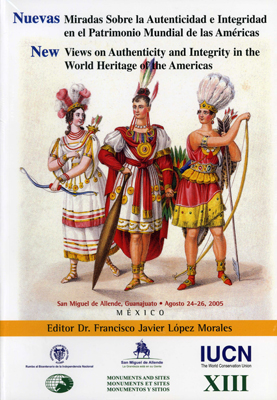

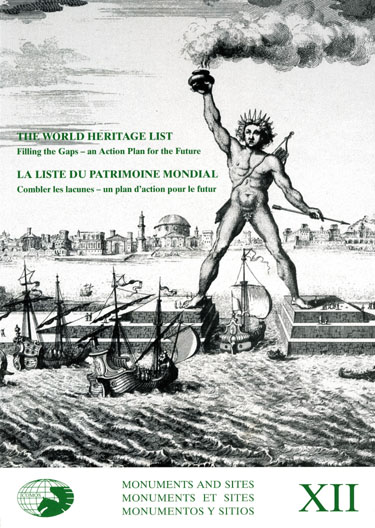
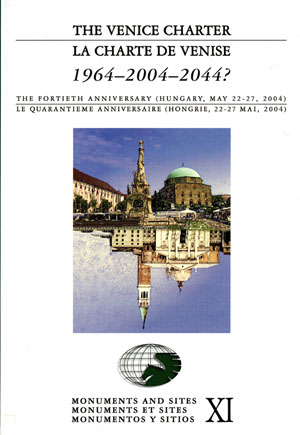

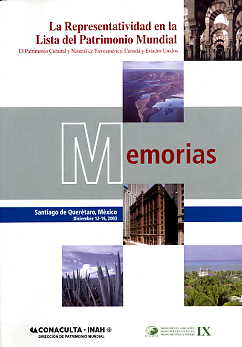 El patrimonio Cultural y Natural
El patrimonio Cultural y Natural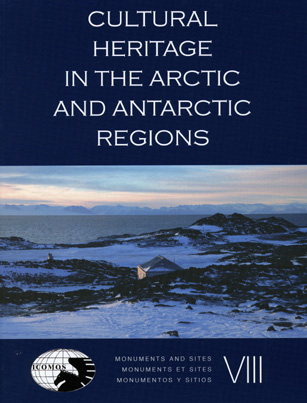 Compiled and edited for the International Polar Heritage Committee of ICOMOS by
Compiled and edited for the International Polar Heritage Committee of ICOMOS by